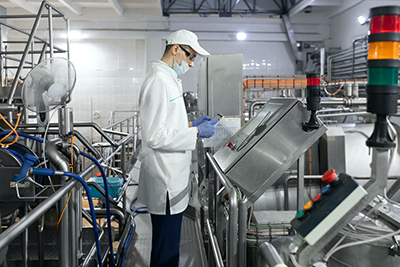Deborah Coviello, founder and CEO of Illumination Partners, LLC and host of The Drop in CEO Podcast, recently shared her journey with the Women in Food Safety Group. Deb believes in self-confidence and that everyone is a talented individual.
Two years ago, Deb decided to start her own business, which focuses on elevating people, after 10 years of working as a food safety professional for a top flavor company. When I spoke with Deb about her experiences, she admitted that at times she felt vulnerable, stressed and unsatisfied after working for corporations for more than 30 years. She was no longer happy with herself, and even her coworkers could see it. However, she got past it and has found the passion to share her experiences and stories to help anyone who is struggling in a similar situation.
When formulating the business plan for her new firm, Deb started testing her ideas with consulting professionals, discussing how to elevate their self-confidence. It wasn’t until her third client that she had built the confidence to say that she could provide a service that people needed. “I have to constantly tell myself that I can do this!” Deb said. “It is that food safety professional combined with elevating leadership—men and women—which is the purpose for my work, and I enjoy doing so much. ” Hearing Deb’s client feedback is what drives her mission and business forward. “I love helping people find their confidence, because that’s what I was once going through,” she explained.
Deb thinks it is more important to help food safety professionals sustain improvement after working with them, versus simply passing on pure technical knowledge. “I elevate people, while at the same time I elevate the business,” she said.
The topic of a glass ceiling is discussed in so many interviews, and Deb would like to challenge that idea. “Maybe in the past, there were challenges to female leadership and we claimed it as a glass ceiling that we had to break through.” Deb continued, “However, I would definitely challenge that! I do not think women need to own that narrative anymore! If you believe there’s a glass ceiling, then you will have a glass ceiling. If you do not believe it, it is not there.”

Deb has one final piece of advice for women who are in an executive position or seeking a position at the table: “Advocate for yourself!” Females have not always been good at speaking up for themselves. However, there are many means to achieve your goals—seek advocates through your network and peers. “Do not ever think people can read your mind,” she added.
She ended the conversation with a personal story that still inspires her today. At one point in her career, she asked her boss at the time what could she change or do to move ahead. Her boss said, “Change nothing, just be yourself!” Deb started gaining the trust and confidence in herself from that point forward. She has become relaxed and more herself—and this is a disposition that gives her energy and helps sustain her passion.
Melody Ge: How did you get into the food safety industry and reach where you are today?
Deborah Coviello: I graduated from college as a biomedical engineer. I knew that I really loved manufacturing because I always loved the creation aspect, going from nothing to something. But along the way, I found out that I enjoyed the area of quality, so I pursued it for several years in multiple industries. One of the things I liked about quality assurance was taking a standard to meet customer expectations. I pursued the ASQ Six Sigma Black Belt to ensure continuous improvement, and I got to learn how to solve problems in business, become more effective and reduce customer complaints. After having my third child, my husband was also changing his business, so I had to return to work sooner than I had planned. I really enjoyed learning about the chemical industry and my skills in quality had evolved, so I landed in the flavors industry, where I started my food safety journey. This is where things started changing for me. I worked for an international flavors company that services the food industry. I became the head of quality for North America for Givaudan, which is the number one global flavors company. It was the dream job that I always wanted. However, it came with a price. Not only did I have to protect the brand by ensuring we delivered a consistent, quality product to our customers; I was also responsible for food safety. At Givaudan, I had a lot of “a-ha” moments realizing that I was in a high-profile, high-risk role. I started taking my job and my voice to the next level because it was such a serious position—I had consumers and professionals around me who depended on me. Food safety was a top priority of mine—not just the compliance aspect but also any area of quality. So that was what took up my time in my previous career before I started my own business in the area of quality, food safety and continuous improvement. Maintaining product safety and brand reputation is a mission that holds true today in my own business.
Ge: What’s your perspective on being a female CEO?
Coviello: Well, there still aren’t a lot of us, although there are more and more female business owners. From 2014–2019, female-owned businesses grew at a rate of about 21% versus all businesses, which grew at about 9%.
I am constantly in search of fellow female CEOs to network with, and share thoughts and challenges. You mentioned a glass ceiling and the need for more women at the table. I appreciate all the female professionals who preceded us, and those who faced adversity to gain the right, trust and respect for all the opportunities that we have now. To give an example of my mother, she was a microbiologist and probably did not have all the opportunities that she would have wanted to in her time. I now have infinite possibilities. I have never felt disadvantaged. I was always able to turn a situation that did not serve me well into a new opportunity. I could take the accountability and move to a different role. I never let people, or the environment, stand in my way. I never felt the fear of any challenges of being a female CEO. I do not feel like I have any extra advantages either. I am simply a person who has a belief in myself and I have established a service through which I can help others.
Ge: Looking back, would you make any decisions differently?
Coviello: Oh yeah, I am much smarter and more confident now. In the past I didn’t believe in my abilities as much as I do now. I used to ask someone’s opinion to validate who I was or how good my performance was. The time was not right for me to start my own business. But looking back, I should have believed more in my capabilities and myself. I probably could have started my business a long time ago. In a way, I was forced into doing it at the end of my last job, and now I realize I am doing the work I was meant to do. I had a great career, and I will continue to have a great career. However, I do feel like I am playing catch-up now. Don’t get me wrong—I have a beautiful life and a very supportive husband. But when I look at successful business people who have 15 years of business experience, I am trying to play catch up. I feel like I have to work a lot faster, which involves business development, marketing, the Podcast, and I am also getting ready to write a book. I am trying to accelerate everything, which maybe I should have been a little bit more methodical if I had enough time. So, I definitely would have started business sooner to achieve all that I want to have an impact on. I would also like to give one piece of advice: Never doubt what you have already accomplished. When you reflect back, you have achieved so much and you should celebrate those successes. There are no failures, [they are] simply steps towards achieving the success you were meant to achieve. When you project yourself forward, ask your self what “is” possible vs. “not” possible. Having a positive mindset and belief in yourself is your guiding light.





















